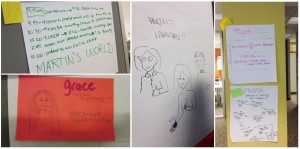 Our office has always had a customer-centric philosophy. We believe it is important to understand and share the feelings of another person or group of people when approaching projects and the customer experiences we are designing. One of the reasons we do this is because we believe that the best user experiences are built on a solid understanding of your users’ needs, their beliefs and their values.
Our office has always had a customer-centric philosophy. We believe it is important to understand and share the feelings of another person or group of people when approaching projects and the customer experiences we are designing. One of the reasons we do this is because we believe that the best user experiences are built on a solid understanding of your users’ needs, their beliefs and their values.
In our work with clients, one of the first things we often do is to take them through an empathy workshop or empathy mapping exercise to help them find meaning and clarity within the scope of the project at hand. We had an opportunity to do this with SickKids Foundation at the organization’s Engagement Day, which was designed to help them visualize the ideal experience for donors.
Before coming to the event, attendees were asked to complete a Heart, Hand and Mind exercise designed to get them thinking about the donor experience from different angles and perspectives and to help them understand how each is significant. For instance; what makes the ideal donor experience emotionally engaging? What makes the experience easy to engage in? What rational needs does the experience satisfy?
With a better understanding of their donors’ needs, the Foundation was able to open the doors for innovation and creativity. The same is true for any company.
In a recent post, I wrote about how I conducted an internal workshop that promoted the use of empathy when trying to solve a problem. We learned that, unless you actively approach a project with empathy, it is easy to fall into old routines; missing key information, indicators or clues that our users are providing, thus preventing innovation and creative solutions.
A few weeks ago I conducted another workshop found in the Gamestorming playbook called Welcome to My World. In this workshop, I wanted our staff to practice the concept of empathy by putting themselves in other people’s shoes. When our staff can understand and share the mindset of other staff members they build stronger relationships and in turn this is reflected in the work we produce.
For the workshop, I had participants create a trading card representation of their role in our office (it included their name, a small picture of themselves, their job position, and a work task e.g., update the company blog, program an online survey, etc.).
For the second part of the workshop, participants paired up with someone whose job they knew very little about or someone they don’t generally work with on a regular basis. Without speaking to one another, each person was tasked to create an innovative visual representation of how they think their partner performs the task they identified on their trading card. After a few minutes the partners met up again and discussed what they had created.
The end result was a lot of laughs and giggles but also a greater understanding of how our co-workers perform their daily tasks. Some participants realized that they had assumed a task was done in a certain way only to learn that there were aspects of the job they missed and that they had made assumptions and didn’t account for specific tasks or processes required by their partners to perform their job. All of our employees were happy to see that their partners recognized the work it took to perform their jobs.
The exercise showed us that we often make assumptions without realizing it and with a simple conversation we can remove those assumptions and gain a better understanding of others. By adding the visual representation, our team members had the opportunity to have fun and get creative with the task at hand. In the end, we learned that with a conscious approach of gaining an understanding of others, and their needs, we free ourselves to be innovative and creative.